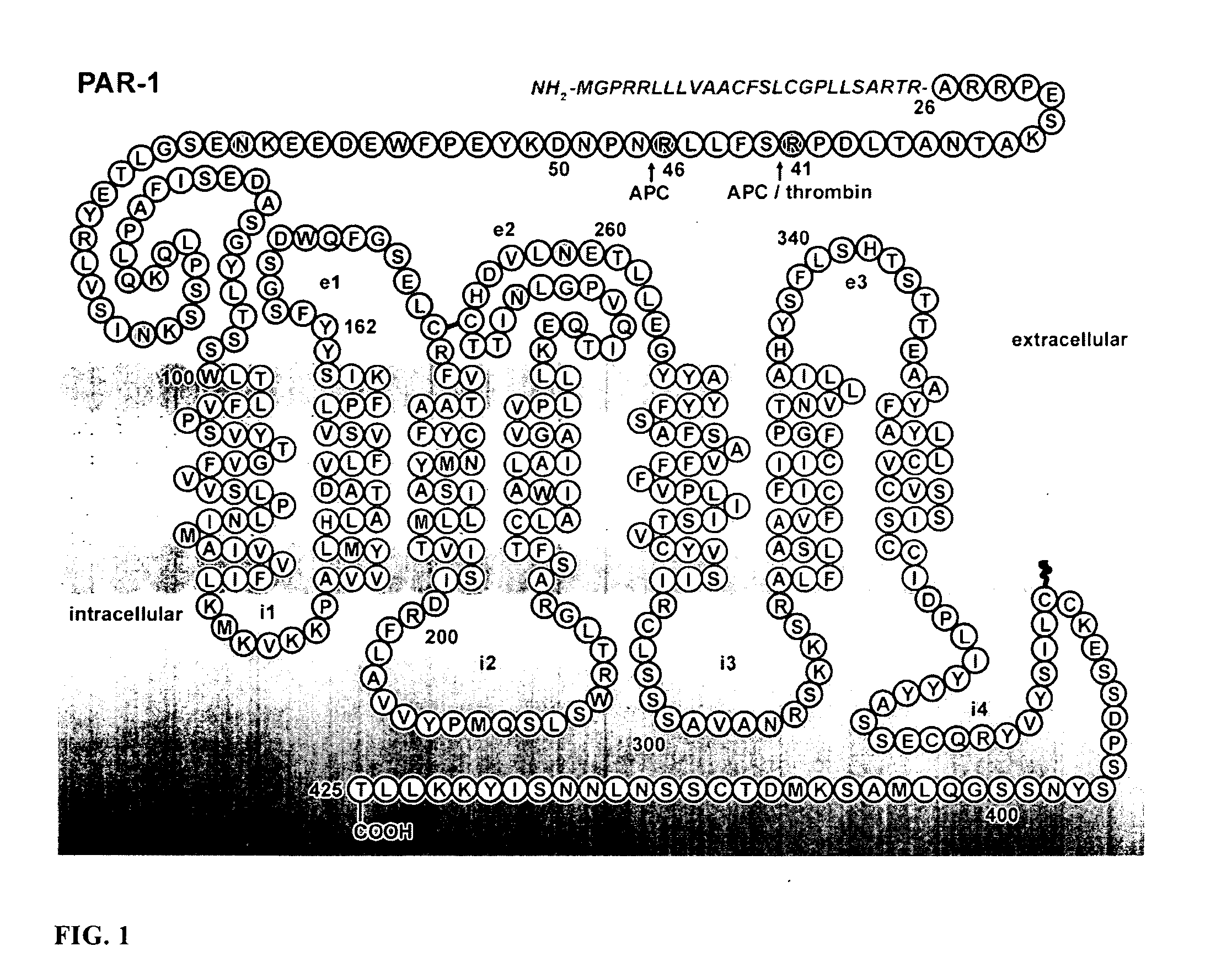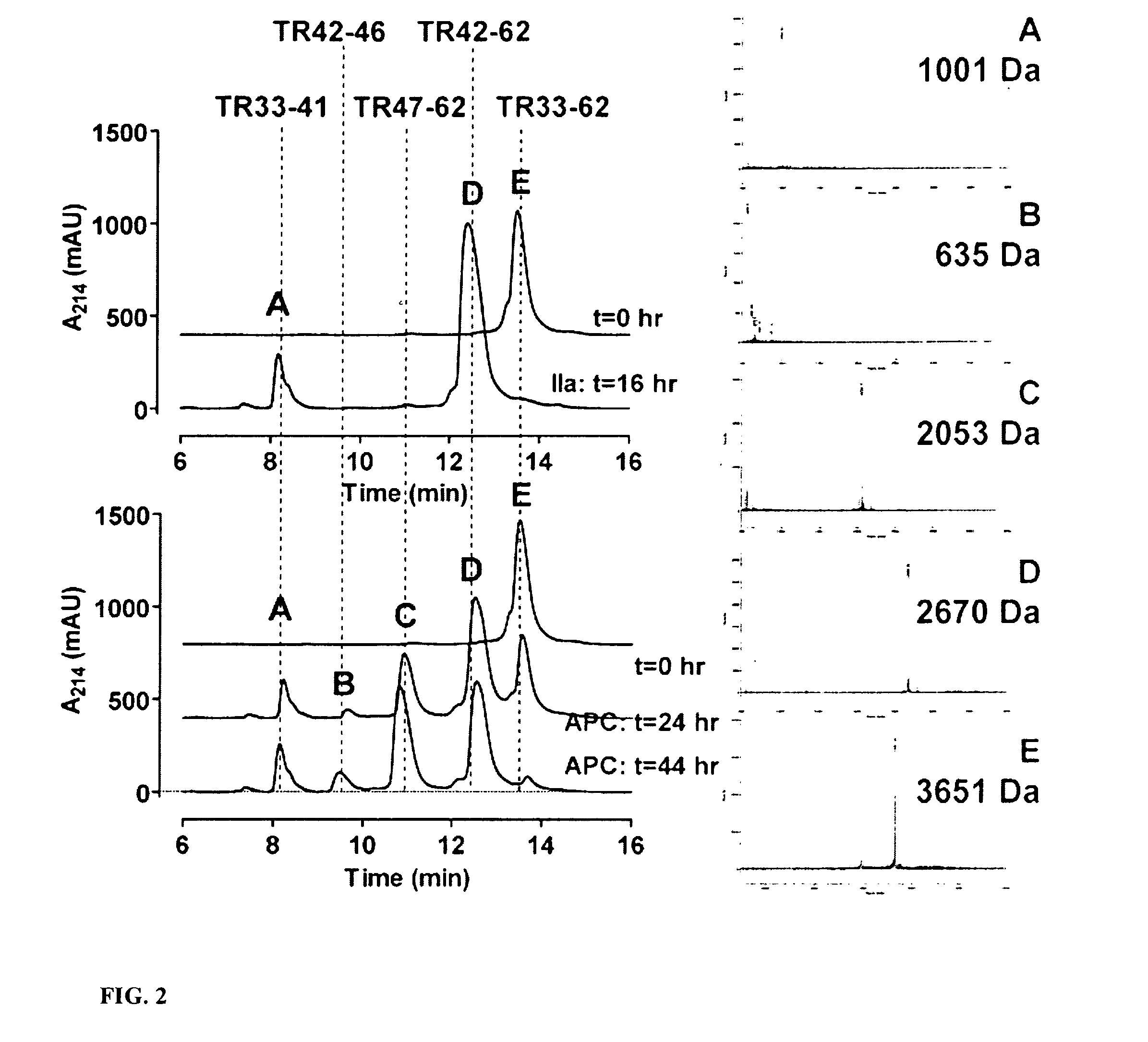Protease Activated Receptor-1 (PAR1) Derived Cytoprotective Polypeptides and Related Methods
a technology of activated receptors and cytoprotective polypeptides, which is applied in the direction of peptide/protein ingredients, drug compositions, metabolic disorders, etc., can solve the problems of affecting the survival of cells or animals, and achieve the activation of the pi3k-akt survival pathway, cytoprotective activity, and the effect of reducing mortality
- Summary
- Abstract
- Description
- Claims
- Application Information
AI Technical Summary
Benefits of technology
Problems solved by technology
Method used
Image
Examples
example 1
Activated Protein C Cleaves a Synthetic PAR1 Peptide (TR33-62) at Arg46
[0105]
Peptide namePeptide sequenceTFLLTFLLRNPNDK(TR42-51 with S42T)(SEQ ID NO: 8)NPND (TR47-66)NPNDKYEPFWEDEEKNESGL(SEQ ID NO: 4)scr-NPNDGDENENEKPNWYELKEPDSF(scrambled TR47-66)(SEQ ID NO: 9)TR24-41TRARRPESKATNATLDPR(SEQ ID NO: 10)TR24-46TRARRPESKATNATLDPRSFLLR(SEQ ID NO: 11)TR42-66SFLLRNPNDKYEPFWEDEEKNESGL(SEQ ID NO: 12)TR33-62ATNATLDPRSFLLRNPNDKYEPFWEDEEKN(SEQ ID NO: 13)
[0106]To characterize APC cleavage sites in PAR1 N-terminal tail, we studied the HPLC patterns from cleavage of a synthetic peptide (“TR33-62”) comprising residues 33-62 of the PAR1 N-terminus by thrombin and APC and got the mass spec values for each observed peak. The results are shown in FIG. 2. In the HPLC profiles, the uncleaved substrate TR33-62 (peak E) gave the correct mass of 3,651 and the two fragments produced by thrombin (peaks A and D) corresponded to masses of 1,001 and 2,670 for cleavage at Arg41 as expected. In contrast to thrombi...
example 2
Activated Protein C (APC) Cleaves PAR1 at Arg46 on Transfected HEK-293 Cells
[0108]To facilitate analysis of APC-mediated PAR-1 activation, we created a full-length PAR-1 construct linked at the N-terminus to an alkaline phosphatase reporter group (SEAP). Selection of stable cell lines expressing both endothelial protein C receptor (EPCR) (wt or E86A) and SEAP-PAR1 allowed for a reliable and reproducible analysis of EPCR-dependent PAR-1 activation by APC. The results are shown in FIG. 3. Mass-spec analysis of cleavage fragments generated by APC of a synthetic PAR-1 N-terminal tail peptide (TR33-62) identified both Arg41 and Arg46 as potential cleavage sites for APC proteolysis, as noted above. To characterize the cleavage of PAR1 by APC on cells, SEAP-PAR1 mutants were generated with either the thrombin cleavage site Arg41 mutated (R4Q-SEAP-PAR1) or the APC cleavage site Arg46 mutated (R46AQ-SEAP-PAR1). R41Q-SEAP-PAR1 was cleaved by APC in the presence of EPCR. This surprising result...
example 3
Activated Protein C Cleaves PAR1 at Arg46 on EA.hy.926 Endothelial Cells
[0111]We showed above that Activated Protein C (APC) cleaves a synthetic PAR1 N-terminal tail peptide at Are and Arg46. On HEK293 cells APC cleaved a SEAP-PAR1 fusion construct at Arg41 and Arg46 when cells were co-transfected with wt-EPCR. To determine whether APC cleaves endogenous PAR1 at the non-canonical Arg46 site on endothelial cells in the presence of endogenous endothelial protein C receptor (EPCR), anti-PAR1 antibodies with defined epitopes were used to characterize the presence or disappearance of specific PAR1 epitopes on the cell surface of EA.hy.926 endothelial cells upon incubation with thrombin or APC. Specifically, PAR1 peptides (Biosynthesis) were synthesized and purified to >95%. Peptides were coated to 96-well maxisorp plates (Nunc) at 10 μM in carbonate buffer pH 9.0. Plates were blocked with Tris (50 mM) buffered saline (150 mM NaCl) pH 7.4 (TBS) containing 3% BSA. Subsequently, antibodies ...
PUM
| Property | Measurement | Unit |
|---|---|---|
| diameter | aaaaa | aaaaa |
| pH | aaaaa | aaaaa |
| pore size | aaaaa | aaaaa |
Abstract
Description
Claims
Application Information
 Login to View More
Login to View More - R&D
- Intellectual Property
- Life Sciences
- Materials
- Tech Scout
- Unparalleled Data Quality
- Higher Quality Content
- 60% Fewer Hallucinations
Browse by: Latest US Patents, China's latest patents, Technical Efficacy Thesaurus, Application Domain, Technology Topic, Popular Technical Reports.
© 2025 PatSnap. All rights reserved.Legal|Privacy policy|Modern Slavery Act Transparency Statement|Sitemap|About US| Contact US: help@patsnap.com



